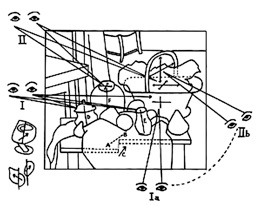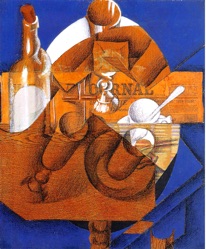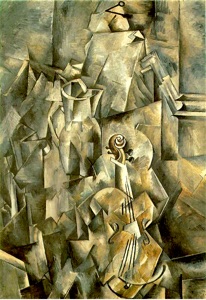
Box 5: Cubism - the Turning Point
A Cubist painting is a formal dissection of seeing, as experienced in a fluid moving space. Its contents and constituent properties are isolated for examination from different points of view, then partially recombined into a pictorial image of unexpected relationships. Although the canvas is consciously composed and structured, and the subjects are real, it is not a representational perspective of reality.
This dynamic manipulative process of partial imagery requires a new context of space. Cubism can’t work unless there is a new arena of flexibility in which to operate, one that provides an open, unrestricted spatial background of uniform continuity that is non-hierarchical. This is modern space, a place for dynamic play in an unstructured free continuum. Cubism provided the definitive transition from formed Space, integral to what eventually became Anti-space:
—Anti-space moves. The transformation of the objects illustrated is a result of a moving observer in a dynamic space, fragmented by time.
—Anti-space is a force, or at least the conveyor of forces, which emanates from objects. Anti-space distorts or transforms form; it is the medium of exchange for the energy of objects.
—Anti-space is independent of geometry, and geometry is itself an independent structure, a grid appearing in both solids and voids.
—Anti-space exists within physical mass. Everything has an aspect of transparency. Nothing is totally solid. All objects have the potential of perceptual penetration.
—Anti-space is ever-present. There is no preferential place for anything, and space is uniformly ambiguous and agnostic.
—Anti-space is uniform and infinite. It obliterates distinctions between figure and ground; there is neither a background nor a limit to the space.
—Anti-space is equated with time. An unknown and indefinite duration is assumed for the observation of a Cubist image. Time is combined with space to have equal value and extent.
—Anti-space promotes collage. Composition is achieved through the juxtaposition of fragments and the acceptance of incompleteness.
The complex intricacy of a Cubist composition is still emotionally moving because it has the magical capacity to dematerialize mass, to transform objects through time and movement, and to reverse the appearance and location of figure and ground. These ambiguities and contradictions result from the conditions of anti-space which are accepted as the basic context of Cubism. Its obliteration of pictorial space confirms the presence of this new spatial framework. The painting thus provides an analysis of the mode of perception which transforms the appearance of things, demonstrating that within anti-space, the experience of form is interpreted as a derivation of personal memory through time and motion.
Formally, this is accomplished through a juxtaposition of fragments and the acceptance of incompleteness: it is the process of collage. Cubism rejects any single interpretation of reality in terms of single position or time, and challenges the simple comprehension which might be elicited by a finite, stable space. It dissects pictorial space into the multiple images produced in time from different “station points”. It represents the frozen moments of a multiplicity of impressions through the dynamic relative motion of the “observer”. It is not about the optics or rays of vision nor the actual three-dimensional real form of the objects. It is an abstract presentation of the conditions of “relativity”. In this way it evokes the process of individual memory. It is representative of the way in which we see, but not of what we see. It is a caricature of experience and perception, interpreted in the simultaneous exposure of multiple impressions (B5-a,b,c).
The lesson of Cubism is not in its depiction of reality as fact, but rather in its demonstration of the actual mode of comprehending within the real, normal, dynamic process of human perception. Cubism establishes a different understanding of our spatial framework. It establishes the parameters for Modern aesthetic space which prioritize the dominance of the non-centralized multitude of individual points of view. This is the aesthetic of unrestrained anti-space.
The Art and Architecture that have followed do not look like Cubism, but they depend on it for justification. They have subscribed to the same spatial paradigm because it can foster diverse individual perception and expressions without constraint, without closure, without boundaries, without perspective, without recourse to geometric space. This is the free blank slate universal void, it is presumed to be homogeneous, infinite, and isotropic (extending uniformly in all directions).
Analysis of a Cezanne painting, by Erle Loran, 1943.
Cubist painting: Pitcher and Violin, Georges Braque, 1909.
Cubist painting: Glass, Cup and Bottle, Juan Gris, 1914.
Page 24



B5-a
B5-b
B5-c


